When foraging in the woods for edible fungi, there is one concern that must be top of mind. You must ensure that you identify the fungus correctly and that the specimen you harvest is, in fact, edible. There are many edible mushrooms, truffles, and morels that can bring delicious, umami flavor to your cooking. However, there are also countless inedible, and toxic, species that will make you sick or could even prove deadly if you eat them by mistake. This article compares and contrasts edible morels, also known as “true morels,” with the generally inedible “false morel” species.
- Morels in the genus Morchella are edible, while false morels include species in the genera Gyromitra and Verpa, with many species called “false morels” in Gyromitra.
- Both morels and false morels grow above ground and are more closely related to truffles than they are to any mushroom species.
- Both grow in the wild in woodland areas and grow near hardwood trees.
- Both have species found in Europe and North America.
However, there are also some major differences between morels and truffles.
- Morels are ectomycorrhizal fungi, while false morels are saprotrophic.
- Morels are edible, while false morels are toxic for humans.
- Morels are hollow on the inside, while false morels have a brittle, cauliflower-like interior.
By the end, you should understand what these species have in common, how they are different, and how you can identify them in the wild. This article will cover where each grows and how to find (or avoid!) them, some common species, and the appearances of each. Let’s explore the similarities and differences between true morels and false morels together now!
Morels vs. False Morels
| Characteristic | Morels | False Morels |
|---|---|---|
| Species | There are about 80 species of morels in the genus Morchella. | Several species are considered “false morels.” These include Verpa bohemica, Gyromitra esculenta, Gyromitra caroliniana, and Gyromitra gigas. |
| Genus | Morchella | Many false morels are in the genera Gyromitra or Verpa, but most species called “false morels” are in Gyromitra. |
| Class | Pezizomycetes | Pezizomycetes |
| Division | Ascomycota | Ascomycota |
| Kingdom | Fungi | Fungi |
| Common Name | True morels, morels | False morels, elephant ears, brain mushrooms |
| Origin | Asia, Europe, North America, and Central America | Europe, North America |
| Description of Fungus | Morels are species in the genus Morchella. Though sometimes called “morel mushrooms,” morels are more closely related to truffles than they are to mushrooms. Morels are fleshy fruiting bodies of fungi and are edible. Morels have a recognizable honeycomb-looking exterior with concave holes and ridges similar to the texture of a walnut shell. Morels are ectomycorrhizal fungi, which live in mutually-beneficial symbiosis with nearby trees or plants. | False morels are the fruiting body of fungi, most of which are species in the Gyromitra genus. Though similar in outward appearance to morels in the genus Morchella, false morels have different internal structures. The three most widely agreed-upon and common “false morel” species are Gyromitra esculenta, Gyromitra gigas, and Gyromitra caroliniana. All three of these contain a chemical that is toxic to humans, and so are not recommended for eating. |
Descriptions of Morels and False Morels
Similarly to mushrooms, morels and the species known as “false morels” are both parts of the wide, diverse kingdom of fungi. Colloquially, both are known as “mushrooms,” though this is technically not correct. Morels and the various false morel species are more similar to each other than to mushrooms, as these species belong to genera in the Ascomycota division and Pezizomycetes class. Because morels and false morels have similar appearances and grow in similar geographies, it is important to know the differences.
Morels are a group of fungi and represent many different edible species. However, there are also several lookalike species known as “false morels.” While true morels are edible and can have complex, rich, savory flavors, false morel species are inedible. Some of them are poisonous and can even prove fatal to those who consume them if not handled correctly. For this reason alone, anyone who hopes to search the wood for morels should learn the common false morel species and how to differentiate between edible true morels and their toxic lookalikes.
Let’s start by describing morels and false morels before comparing and contrasting some specific details of each.
Morels
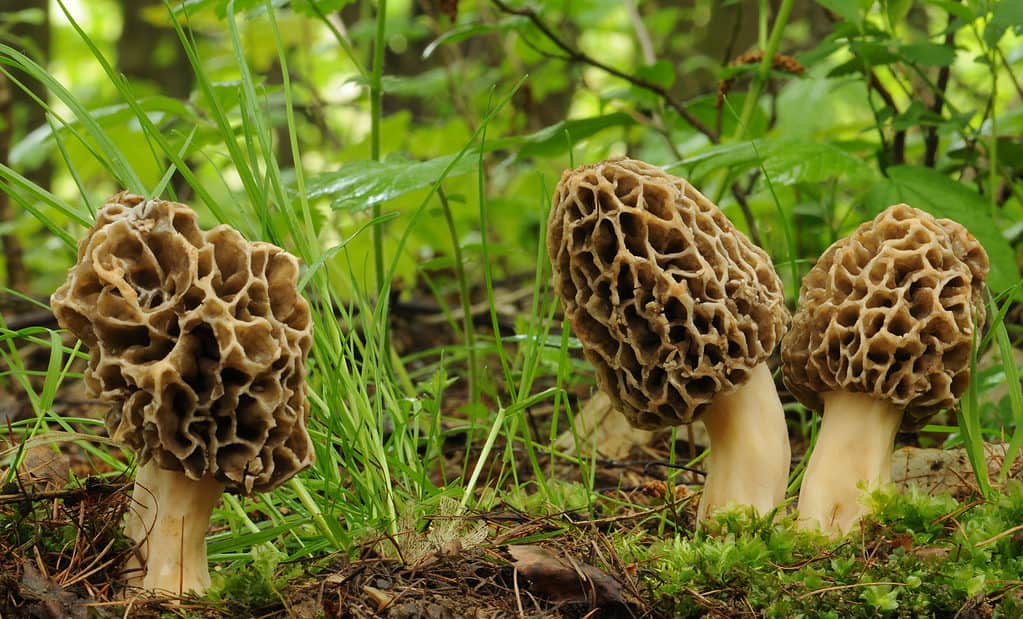
Another name for morels is true morels, in contrast to the toxic false morels.
©Tomasz Czadowski/Shutterstock.com
Morels, “morel mushrooms,” or “true morels” (in contrast to the “false morel” species), are the many different species of the genus Morchella. This genus contains dozens of different species, which vary in size and appearance. The edible part of the fungi is its fruiting body, which appears early in the spring and grows throughout the spring in woodland areas and the edges of forests.
Morels have a honeycomb-like exterior that has many pits and ridges. Because morels are often brown or black in color, they can also look similar to the shell of a walnut, with ridges and bumps. The shape of the cap varies by species, with some looking egg-shaped, oblong, or like bells. Morels range in size from 2 to 12 inches tall, with the youngest ones in early spring starting small and growing over the course of the season.
You can find morels growing in woodland environments of the Northern Hemisphere, including in parts of Asia, Europe, and North America. There, they appear near the edges of forests, they live in mutually beneficial, symbiotic relationships with plants such as oak, elm, aspen, and ash trees. When morels first appear in early spring, they will be small – with caps as tiny as a little acorn. Later in the season, the morels may begin to peak out from underneath leaves and other forest debris.
A few of the most well-known morel species are Morchella elata, called the “black morel,” Morchella esculenta, the “common morel,” and Morchella deliciosa, the “late morel.” While morels are edible, they do have a few lookalikes that are toxic. Foragers should identify these toxic lookalikes to avoid accidental consumption.
False Morels

As toxic lookalikes to morels, false morels are dangerous.
©FotoLot/Shutterstock.com
Like morels, the part of false morels that you see is the fruiting body of the fungi species. Many so-called “false morels” are in the genus Gyromitra. Some of the most common species of “false morels” are the species Gyromitra esculenta, Gyromitra caroliniana, and Gyromitra gigas. Species in this genus vary greatly in appearance. However, the species considered “false morels” tend to have some shared attributes. They typically have red, brown, or yellow-brown caps, and stems, which have brain-like folds and grooves on the outside. Depending on the species, false morels can have caps that are between 2 and 10 inches across, with stalks that are 2 to 5 inches tall and anywhere from 1 to 4 inches in diameter.
Various false morel species grow in North America and some parts of Europe. You can find them growing in hardwood and sometimes conifer forests. There, they enjoy rich soil and often appear near rotting wood or fallen trees. This is because false morel species are saprotrophic fungi. This means that they gain nutrients from feeding on dead or decaying wood. This is different from true morels, which, as mycorrhizal fungi, have symbiotic relationships with living trees.
The edibility of false morels is debated. They do have a chemical that becomes a toxic compound when digested by humans. This can lead to severe symptoms or death for those who consume false morels, if they do not receive medical treatment promptly. However, as we discuss later, certain species of false morels have been eaten, particularly in Europe, for hundreds of years. To this day, they appear in culinary traditions in countries such as Russia and the Czech Republic. Despite this, it is generally not advised to consume any part of a false morel.
Key Differences Between Morels and False Morels
Just from those brief descriptions, you can gather that there are a few characteristics that morels and false morels share. Let’s go a bit deeper in learning more about the differences between morels and false morels when it comes to appearance, growing needs, and the history and origins of each.
Appearance
Morels

The hollow interior of morel mushrooms is an easy indicator that you have a true morel.
©iStock.com/Helin Loik-Tomson
Morels have an extremely unique appearance among their fungi relatives. Though their color and shape vary depending on the species, morel species typically share a very unique look by having similarly textured exteriors. Their caps have deep pits that give morels a honeycomb-like appearance. The caps are covered in pits and ridges, but are hollow on the inside. These pitted caps can be brown, olive-colored, gray, yellow-brown, gray, or even black. You will find them in a number of different shapes, with some looking egg-shaped, oblong, or bell-shaped, in a range of sizes from 2 to 12 inches tall.
False Morels
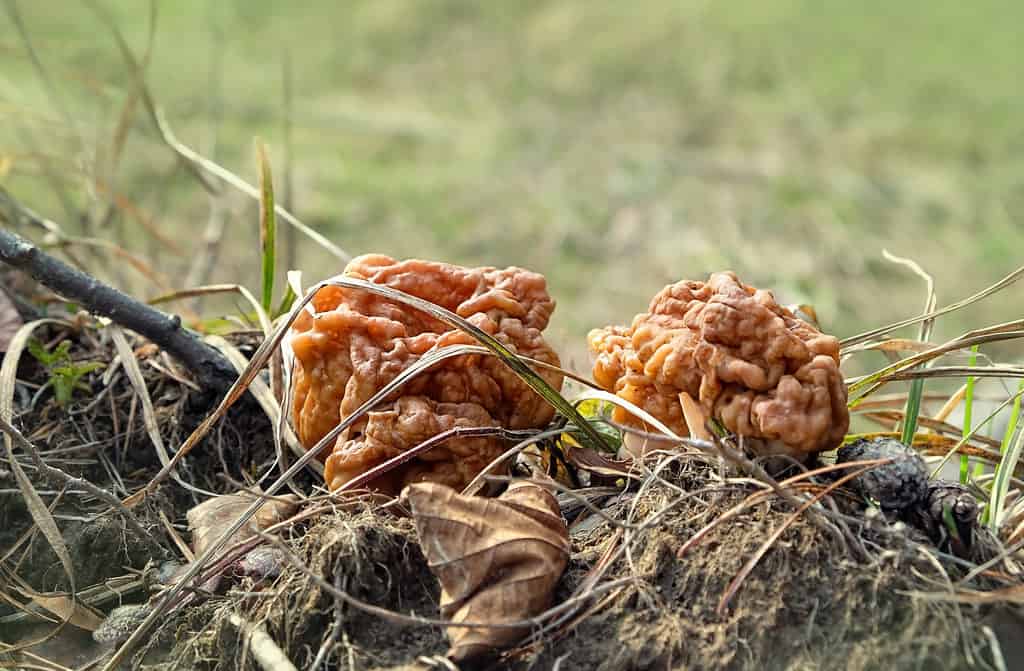
With their unique grooves, false morels sometimes look like brains.
©ju_see/Shutterstock.com
False morel species also have a range of sizes, shapes, and colors. However, rather than having a honeycomb-like, pitted exterior, some false morel species look more like brains, with ridges and grooves. This is one reason that certain false morels are nicknamed “brain mushrooms.” False morels can have red, brown, or yellow-brown caps that grow to be between 2 and 10 inches across. Their well-defined stalks can reach between 2 and 5 inches tall. False morels can look a little bit like miniature tree shapes, in that they have a strong stalk (or “stipe”) that holds up a bulbous cap, which looks like a strong tree trunk holding up plentiful foliage. When sliced open, false morels are not hollow, unlike true morels. Rather, their insides are chambered and brittle.
Origins and Growing Environment
Morels
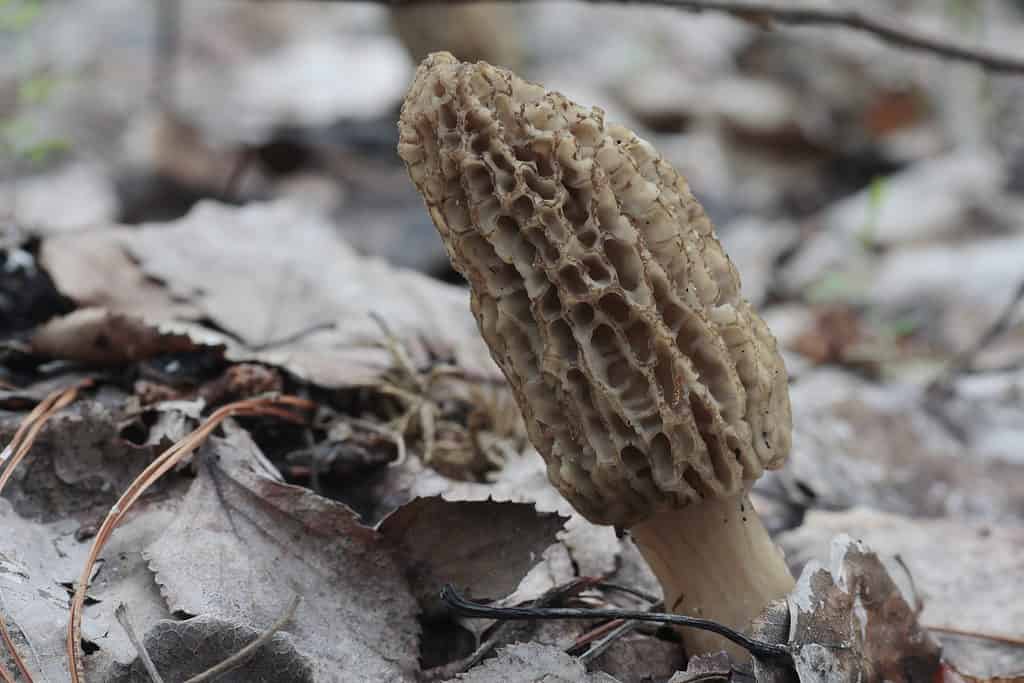
Mycologists believe that morels are mycorrhizal fungi, meaning they live in symbiosis with living trees, rather than feed off of dead ones.
©ressormat/Shutterstock.com
Though morels have been eaten for centuries, in western mycology (the study of mushrooms), morels were initially recorded in the 1700s and reclassified in 1801. Though morels have been cultivated for human consumption for several decades, there is not yet widespread commercial cultivation. Because of this, morels are primarily harvested from the wild where they grow in wooded areas in countries across the Northern Hemisphere, especially in the United States and parts of Europe.
Morels appear in the spring in grassy areas, conifer and hardwood forests, and even mountain climates. They even appear at times in flower beds or forests that have recently burned. If you would like to forage morels, you may search for them around the perimeter of forests or other woodland areas and near dead oak or aspen trees. Morels grow well in soft, moist soil that allows the mycelium to access nutrients from tree roots.
Historically, morels were believed to be saprotrophic and gained nutrients from dead or decaying trees. However, mycologists now think that morels are actually a group of mycorrhizal species. As mycorrhizal fungi, morels gain nutrients from the roots of living trees. Rather than breaking down the organic matter to contribute to decay and decomposition, they live in symbiosis with the trees they grow near.
False Morels
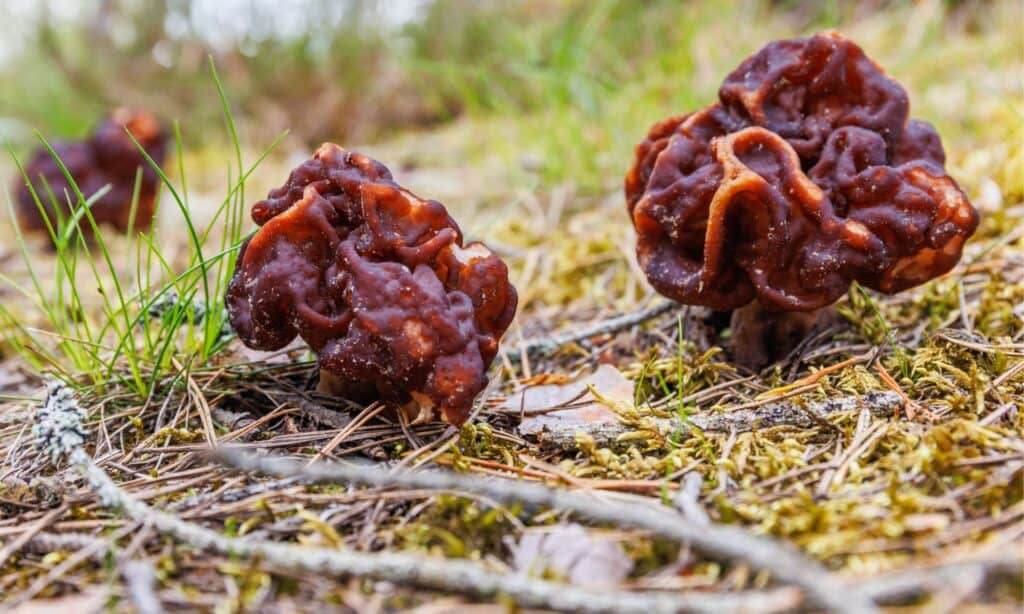
Growing throughout Europe, as well as some parts of Asia and the United States, false morels cover a wide geographic area.
©iStock.com/TT
False morels grow across a wide geographic area. They appear throughout Europe, some parts of Asia, and North America, where it is most commonly found in the Midwestern United States and Pacific Northwest. Certain species can even thrive in hot, dry climates like those of North Africa or in the Rocky Mountain region of the United States. In general, false morels grow in deciduous forests that are abundant with oak and maple trees as well as in woodland areas with conifers. They appear in forests that have soil rich in silica, where there are plentiful sands of rocks such as quartz, sandstone, granite, and others.
There, you may find false morels appearing in the ground during the spring and summer months, often individually or in small groups.
As a group of saprotrophic species, false morels get nutrients by feeding on dead and decaying organic matter. In particular, false morels feed on dead wood from hardwood tree species. However, there is some research to suggest that a few false morel species do exhibit signs of being both saprotrophic and mycorrhizal at different points in their growth cycle.
Taste and Edibility
Morels

Prized for their flavor, morels must be cooked before eating.
©Mircea Costina/Shutterstock.com
Morels are edible and described as having a pleasantly earthy, nutty flavor. Some people report that darker-colored morels bring stronger flavor. Their texture is dense and meaty. Because of this, morels can be enjoyed as an ingredient in soups or sauces or pan-fried with oil and butter.
False Morels
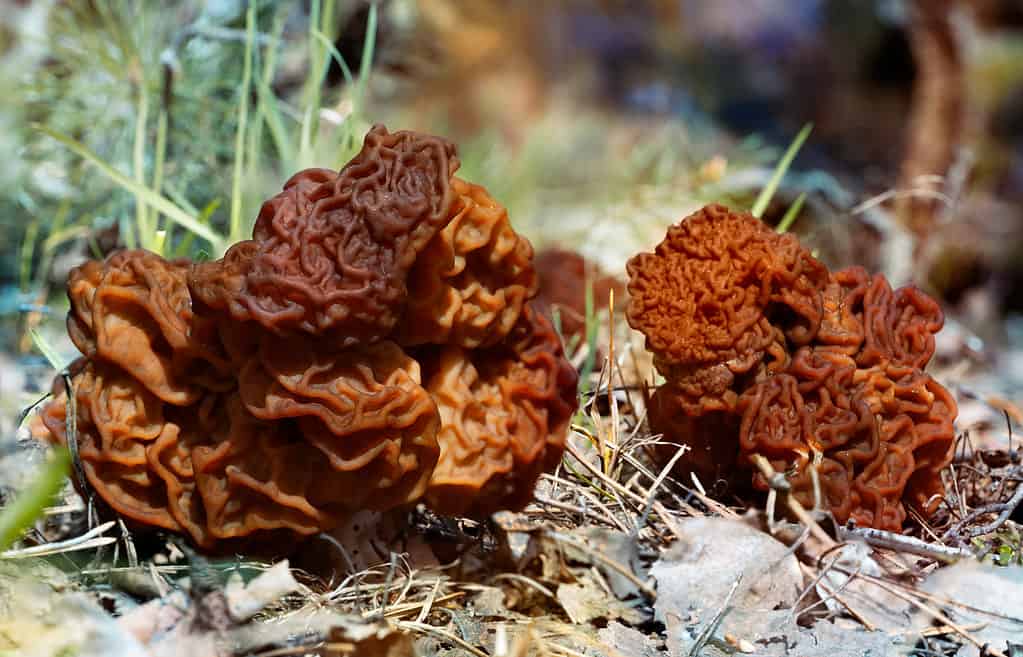
Due to their toxicity, false morels are not edible.
©Ksenia Lada/Shutterstock.com
In contrast, false morels are not edible. Species in the Gyromitra genus have caused numerous deaths as well as hospitalizations and long-term health impacts for those who have consumed false morel species. False morels contain a chemical called gyromitrin. When heated or digested by human bodies, this chemical becomes a toxic compound called monomethylhydrazine. Monomethylhydrazine poisons the human nervous system. This can cause symptoms like nausea, vomiting, diarrhea, muscle cramps, faintness, and stomach pain. In the worst cases, it can cause the person who consumed it to go into a coma. It can even cause death.
However, certain species, such as Gyromitra esculenta, have been eaten by humans in Europe for a very long time. This species was even sold at local markets throughout the 20th century, before people understood the risk of poisoning. However, in countries such as Finland and Russia, Gyromitra esculenta is still available for purchase. They are considered to be somewhat edible after being parboiled. When parboiled, the species may not cause any poisoning symptoms. However, the toxins from eating this species can build up over time – eventually leading to severe poisoning after repeated consumption. Though there are methods that can “detoxify” the false morels, many experts warn that it is simply not worth the risk.
Other false morel species, such as Gyromitra carolina, are safe to eat and no more dangerous than the true morels in the Morchella genus. However, it is very important to be cautious when identifying or attempting to harvest any fungus species from the wild, including a specimen you believe may be a false morel.
In Summary
As this article explained, morels and false morels are two groups of fungi that grow in the wild and can be found in forested woodland areas. You may enjoy learning to identify wild fungi that you can search for and harvest from the wild. This can be a lot of fun, but it is equally important to learn to identify the inedible lookalike species that masquerade as beloved edible species.
While morels are edible, false morel species range from technically edible to very toxic to an extent that can even prove fatal. Because of this, you should be very careful when attempting to identify or harvest any fungi species from the wild – and be sure to look for key identifiers that tell you whether a species may possibly be edible or if it has the telltale signs of a toxic species.
The information presented on or through the Website is made available solely for general informational purposes. We do not warrant the accuracy, completeness, or usefulness of this information. Any reliance you place on such information is strictly at your own risk. We disclaim all liability and responsibility arising from any reliance placed on such materials by you or any other visitor to the Website, or by anyone who may be informed of any of its contents. None of the statements or claims on the Website should be taken as medical advice, health advice, or as confirmation that a plant, fungus, or other item is safe for consumption or will provide any health benefits. Anyone considering the health benefits of particular plant, fungus, or other item should first consult with a doctor or other medical professional. The statements made within this Website have not been evaluated by the Food and Drug Administration. These statements are not intended to diagnose, treat, cure or prevent any disease.
Thank you for reading! Have some feedback for us? Contact the AZ Animals editorial team.








